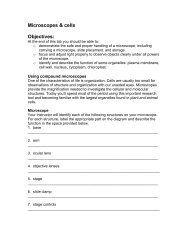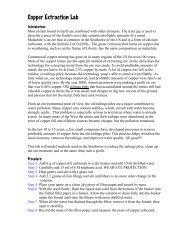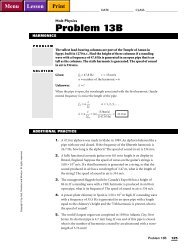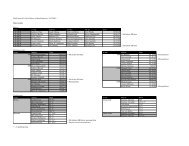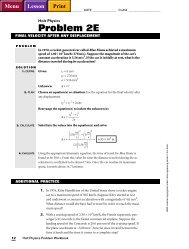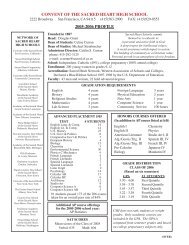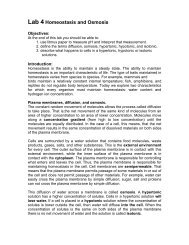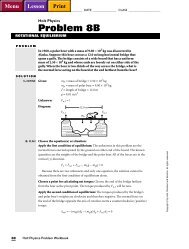Problem 2A - Hays High School
Problem 2A - Hays High School
Problem 2A - Hays High School
- No tags were found...
You also want an ePaper? Increase the reach of your titles
YUMPU automatically turns print PDFs into web optimized ePapers that Google loves.
NAME ______________________________________ DATE _______________ CLASS ____________________<br />
Holt Physics<br />
<strong>Problem</strong> <strong>2A</strong><br />
AVERAGE VELOCITY AND DISPLACEMENT<br />
PROBLEM<br />
The fastest fish, the sailfish, can swim 1.2 × 10 2 km/h. Suppose you have<br />
a friend who lives on an island 16 km away from the shore. If you send<br />
a message using a sailfish as a messenger, how long will it take for the<br />
message to reach your friend<br />
SOLUTION<br />
Given: v avg = 1.2 × 10 2 km/h<br />
∆x = 16 km<br />
Unknown: ∆t = <br />
Use the definition of average speed to find ∆t.<br />
v avg = ⎯ ∆ ⎯<br />
x<br />
∆t<br />
Rearrange the equation to calculate ∆t.<br />
∆x<br />
∆t = ⎯⎯<br />
v avg<br />
16 km<br />
∆t = ⎯⎯⎯ =<br />
1.2 × 10 2 ⎯ k m<br />
h<br />
⎯<br />
1 h<br />
⎯⎯ 60 min<br />
<br />
= 8.0 min<br />
16<br />
km<br />
⎯⎯<br />
2.0 km/<br />
min<br />
HRW material copyrighted under notice appearing earlier in this book.<br />
ADDITIONAL PRACTICE<br />
1. The Sears Tower in Chicago is 443 m tall. Joe wants to set the world’s<br />
stair climbing record and runs all the way to the roof of the tower. If Joe’s<br />
average upward speed is 0.60 m/s, how long will it take Joe to climb from<br />
street level to the roof of the Sears Tower<br />
2. An ostrich can run at speeds of up to 72 km/h. How long will it take an<br />
ostrich to run 1.5 km at this top speed<br />
3. A cheetah is known to be the fastest mammal on Earth, at least for short<br />
runs. Cheetahs have been observed running a distance of 5.50 × 10 2 m<br />
with an average speed of 1.00 × 10 2 km/h.<br />
a. How long would it take a cheetah to cover this distance at this speed<br />
b. Suppose the average speed of the cheetah were just 85.0 km/h.<br />
What distance would the cheetah cover during the same time interval<br />
calculated in (a)<br />
<strong>Problem</strong> <strong>2A</strong> 3
NAME ______________________________________ DATE _______________ CLASS ____________________<br />
4. A pronghorn antelope has been observed to run with a top speed of<br />
97 km/h. Suppose an antelope runs 1.5 km with an average speed of<br />
85 km/h, and then runs 0.80 km with an average speed of 67 km/h.<br />
a. How long will it take the antelope to run the entire 2.3 km<br />
b. What is the antelope’s average speed during this time<br />
5. Jupiter, the largest planet in the solar system, has an equatorial radius of<br />
about 7.1 × 10 4 km (more than 10 times that of Earth). Its period of rotation,<br />
however, is only 9 h, 50 min. That means that every point on<br />
Jupiter’s equator “goes around the planet” in that interval of time. Calculate<br />
the average speed (in m/s) of an equatorial point during one period<br />
of Jupiter’s rotation. Is the average velocity different from the average<br />
speed in this case<br />
6. The peregrine falcon is the fastest of flying birds (and, as a matter of fact,<br />
is the fastest living creature). A falcon can fly 1.73 km downward in 25 s.<br />
What is the average velocity of a peregrine falcon<br />
7. The black mamba is one of the world’s most poisonous snakes, and with<br />
a maximum speed of 18.0 km/h, it is also the fastest. Suppose a mamba<br />
waiting in a hide-out sees prey and begins slithering toward it with a<br />
velocity of +18.0 km/h. After 2.50 s, the mamba realizes that its prey can<br />
move faster than it can. The snake then turns around and slowly returns<br />
to its hide-out in 12.0 s. Calculate<br />
a. the mamba’s average velocity during its return to the hideout.<br />
b. the mamba’s average velocity for the complete trip.<br />
c. the mamba’s average speed for the complete trip.<br />
8. In the Netherlands, there is an annual ice-skating race called the “Tour of<br />
the Eleven Towns.” The total distance of the course is 2.00 × 10 2 km, and<br />
the record time for covering it is 5 h, 40 min, 37 s.<br />
a. Calculate the average speed of the record race.<br />
b. If the first half of the distance is covered by a skater moving with<br />
a speed of 1.05v, where v is the average speed found in (a), how<br />
long will it take to skate the first half Express your answer in hours<br />
and minutes.<br />
HRW material copyrighted under notice appearing earlier in this book.<br />
4<br />
Holt Physics <strong>Problem</strong> Workbook
Motion In One Dimension<br />
Chapter 2<br />
Additional Practice <strong>2A</strong><br />
Givens<br />
Solutions<br />
1. ∆x = 443 m<br />
v avg = 0.60 m/s<br />
∆x<br />
443<br />
m<br />
∆t = ⎯⎯ = ⎯⎯ = 740 s = 12 min, 20 s<br />
v avg<br />
0 .60<br />
m/s<br />
2. v avg = 72 km/h<br />
∆x = 1.5 km<br />
∆x<br />
1.5 km<br />
∆t = ⎯⎯ = ⎯⎯ = 75 s<br />
v avg<br />
72 ⎯k m ⎯<br />
h ⎯ 1 h<br />
⎯ 3600s<br />
3. ∆x = 5.50 × 10 2 m<br />
v avg = 1.00 × 10 2 km/h<br />
∆x<br />
5.50 × 10 2 m<br />
a. ∆t = ⎯⎯ = ⎯⎯⎯⎯ =<br />
v<br />
<br />
avg<br />
1.00 × 10 2 ⎯ k m<br />
h<br />
⎯<br />
1 h<br />
⎯⎯ 36 00s<br />
<br />
⎯ 1 000<br />
m<br />
⎯<br />
1 km<br />
<br />
19.8 s<br />
II<br />
v avg = 85.0 km/h<br />
b. ∆x =∆v avg ∆t<br />
1 h<br />
∆x = (85.0 km/h) <br />
⎯⎯ 36 00s<br />
<br />
⎯ 1 3<br />
0 m<br />
⎯<br />
1 km<br />
<br />
(19.8 s) = 468 m<br />
Copyright © by Holt, Rinehart and Winston. All rights reserved.<br />
4. ∆x 1 = 1.5 km<br />
v 1 = 85 km/h<br />
∆x 1 = 0.80 km<br />
v 2 = 67 km/h<br />
5. r = 7.1 × 10 4 km<br />
∆t = 9 h, 50 min<br />
a. ∆t tot =∆t 1 +∆t 2 = ⎯ ∆ x1<br />
⎯ + ⎯ ∆ x2<br />
⎯<br />
v1<br />
v2<br />
1.5 km<br />
0.80 km<br />
∆t tot = ⎯⎯ + ⎯⎯ =64 s + 43 s = 107 s<br />
67 ⎯k m ⎯<br />
h ⎯ 1 h<br />
⎯<br />
85 ⎯k m ⎯ <br />
h ⎯ 1 h<br />
⎯ 3600s<br />
3600s<br />
∆x 1.5 km + 0.80 km 2.3 km<br />
b. v avg = 1 +∆x<br />
⎯ 2<br />
= ⎯⎯ = ⎯⎯ = 77 km/h<br />
∆t1 +∆t 2 (64 s + 43 s) 1 h<br />
(107 s) 1 h<br />
⎯36<br />
⎯ <br />
⎯3<br />
⎯ 600<br />
00s<br />
∆x = 2πr<br />
∆x 2π(7.1 × 10 7 m)<br />
4.5 × 10 8 m<br />
v avg = ⎯ = ⎯⎯⎯⎯ = ⎯⎯⎯<br />
∆t<br />
60<br />
s<br />
(540 min + 50 min) ⎯ ⎯<br />
(9 h) ⎯60 min<br />
⎯ <br />
1 h<br />
+ 50 min ⎯ 60<br />
s<br />
⎯ 1 min<br />
1 min<br />
4.5 × 10 8 m<br />
v avg = ⎯⎯<br />
60<br />
s<br />
(590 min) ⎯ ⎯ 1 min<br />
v avg = 1.3 × 10 4 m/s<br />
Thus the average speed = 1.3 × 10 4 m/s.<br />
On the other hand, the average velocity for this point is zero, because the point’s displacement<br />
is zero.<br />
Section Two — <strong>Problem</strong> Workbook Solutions II Ch. 2–1
Givens<br />
6. ∆x = –1.73 km<br />
∆t = 25 s<br />
Solutions<br />
∆x<br />
v avg = =⎯ –1.73 × 10 3 m<br />
⎯ ⎯ = –69 m/s = –250 km/h<br />
∆t 25<br />
s<br />
7. v avg,1 = 18.0 km/h<br />
∆t 1 = 2.50 s<br />
∆t 2 = 12.0 s<br />
1 h<br />
a. ∆x 1 = v avg,1 ∆t 1 = (18.0 km/h) <br />
⎯⎯ 36 00s<br />
<br />
⎯ 1 3<br />
0 m<br />
⎯<br />
1 km<br />
<br />
(2.50s) = 12.5 m<br />
∆x 2 = –∆x 1 = –12.5 m<br />
v avg,2 = ⎯ ∆ x<br />
⎯ 2 = ⎯ – 12.<br />
5 m<br />
⎯ =<br />
∆t 2 12.<br />
0 s<br />
–1.04 m/s<br />
b. v avg,tot = ⎯ ∆ x1<br />
+ ∆x2<br />
⎯ = ⎯ 12. 5 m + (−12.5<br />
m) 0.0 m<br />
⎯ = ⎯ =<br />
∆t1<br />
+ ∆t 2 2.50<br />
s + 12.0<br />
s 14.5 s<br />
0.0 m/s<br />
II<br />
c. total distance traveled =∆x 1 – ∆x 2 = 12.5 m – (–12.5 m) = 25.0 m<br />
total time of travel =∆t 1 +∆t 2 = 2.50 s + 12.0 s = 14.5 s<br />
average speed = ⎯ to tal<br />
distance<br />
⎯ = ⎯ 2 5.<br />
0 m<br />
⎯ = 1.72 m/s<br />
total<br />
time<br />
14.<br />
5 s<br />
8. ∆x = 2.00 × 10 2 km<br />
∆t = 5 h, 40 min, 37 s<br />
a. v avg = ⎯ ∆ x<br />
2.00 × 10 5 m<br />
⎯ = =⎯ 2.0 0 × 10 5 ⎯⎯⎯⎯⎯ ⎯<br />
∆t<br />
0s<br />
s<br />
20<br />
437<br />
sm<br />
5 h ⎯360 60<br />
⎯<br />
h <br />
+ <br />
40 min <br />
⎯ ⎯ m in<br />
+ 37 s <br />
v avg =<br />
9.79 m/s = 35.2 km/h<br />
v avg = (1.05)v avg<br />
∆x = ⎯ 1 2 ⎯ ∆x<br />
⎯2.00 × 10 5 m<br />
⎯ 2<br />
∆x<br />
b. ∆t = ⎯ = ⎯⎯ =9.73 × 10 3 s<br />
vavg <br />
(1.05) <br />
9.79 ⎯ m s ⎯ <br />
∆t = (9.73 × 10 3 1 h<br />
s) <br />
⎯⎯ 36 00s<br />
<br />
= 2.70 h<br />
(0.70 h) <br />
⎯ 60 min<br />
⎯<br />
1h<br />
<br />
= 42 min<br />
∆t = 2 h, 42 min<br />
Copyright © by Holt, Rinehart and Winston. All rights reserved.<br />
II Ch. 2–2<br />
Holt Physics Solution Manual




